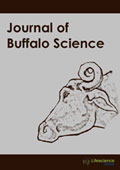jbs
Abstract : Physiological and Behavioral Changes of Water Buffalo in Hot and Cold Systems: Review
|
|
Abstract: This review's objective is to provide information on the mechanisms that buffaloes express during the thermoregulation process. Generally, the water buffalo is associated with warm and tropical climates. In these systems, the combination of high temperature, relative humidity, and radiation cause different physiological and behavioral changes, particularly during the summer months. Wallowing behavior in water or mud promotes heat dissipation through physical mechanisms, such as conduction, convection, and radiation. Furthermore, the provision of natural or artificial shades contributes to thermoregulation and maintains homeostasis. In production systems in cold climates, the wallowing behavior is inhibited by the water temperature, so it is important to keep the animals protected in stables to avoid the cold winds and rapid drops in temperature, causing increased illness pneumonia and sometimes death. Finally, in cold conditions, the animals require an appropriate diet since the use of energy is distributed mainly for the production of heat. Thus, heat stress and cold stress generates relevant problems in health, welfare, and productivity in water buffaloes. A comprehensive assessment of the severity of the resulting problems associated with thermal stress and specialty in cold stress in water buffaloes is necessary so far, and there's very little information about it in this species. Keywords: Cold stress, thermal stress, microclimate, behavior, welfare. |
Abstract : Current Trends in Buffalo Milk Production
|
|
Abstract: Between 1961 and 2018 on the total number of dairy ruminants, the percentage of buffaloes and the quantity of milk produced by them had an increasing trend from 3.7% to 5.2% and from 5.4 to 15.7%, respectively; this value on the world total "cow milk + buffalo milk" rose to 18.64%. Keywords: Buffalo milk, world buffalo milk, italian buffalo milk. |
Abstract : Reproductive Performance of Water Buffalo Cows: A Review of Affecting Factors
|
|
Abstract: This article aims to review both the economic impact of reproductive failures on the profitability of water buffalo systems and the effect of different factors on the reproductive performance of water buffaloes. Besides, an overview of various non-hormonal alternatives to improve reproductive performance is made. The optimal reproductive efficiency in water buffaloes implies calving to conception interval around 90 days to reach a calving interval of 400 days, with longer calving intervals having a negative impact on profitability. Reproductive efficiency is the consequence of the interaction of genetic and non-genetic factors, and the recognition of these factors by analyzing the reproductive information must be a priority. Although each factor's impact can be of greater or lesser magnitude depending on the conditions of each herd, some factors like nutrition, milk yield, body condition score, negative energy balance, parity, bull presence, low estrus intensity, and season can be considered high-impact factors. Not all factors are common among farms; therefore each farm must implement a program for the identification, control, and prevention of reproductive problems, especially during early lactation, to prevent a long anestrus; and when artificial insemination is used, so that it is done at the correct time with respect to the beginning of estrus to enhance fertility. Keywords: Parity, season, BCS, energy balance, milk yield, silent estrus, anestrus. |
Abstract : Effect of Polyvinylpyrrolidone on Vitrification of Buffalo (Bubalus bubalis) Oocytes
|
|
Abstract: Vitrification, a method of rapid cooling, is an alternate cryopreservation method of oocytes and embryos. The present study was aimed to examine the effect of polyvinylpyrrolidone (PVP) on vitrification of buffalo oocytes. Cumulus oocyte complexes (COCs) with fully grown oocytes (120-130 µm in diameter) were aspirated from slaughtered buffalo ovaries for vitrification. COCs were treated with equilibration solution at room temperature for 5 min and then transferred to a vitrification solution for 1 min. Then the COCs were submerged into liquid nitrogen (-196̊C) for a while using cryotops. The COCs were thawed, diluted, and washed in a washing solution for 5 min, respectively. Vitrified oocytes were incubated for in vitro maturation (IVM) at 38.5̊C under an atmosphere of 5% CO2 in the air for 24 hrs. Cumulus cells surrounding the oocytes were removed mechanically, oocytes were fixed in acetic acid and ethanol, and stained with aceto-orcein to examine the meiotic stages of oocytes. The numbers of morphologically normal oocytes after vitrification were higher in 5% PVP than 0 and 10% PVP groups. A proportion of oocytes treated with 5% PVP reached the metaphase II (MII) stage while none of the oocytes from 0% and 10% PVP groupsdeveloped beyond anaphase I and metaphase I (MI) stages, respectively. These results show that PVP can be used as a cryoprotectant for the vitrification of buffalo oocytes. Keywords: Buffalo, cryopreservation, in vitro maturation, oocytes, PVP. |






















